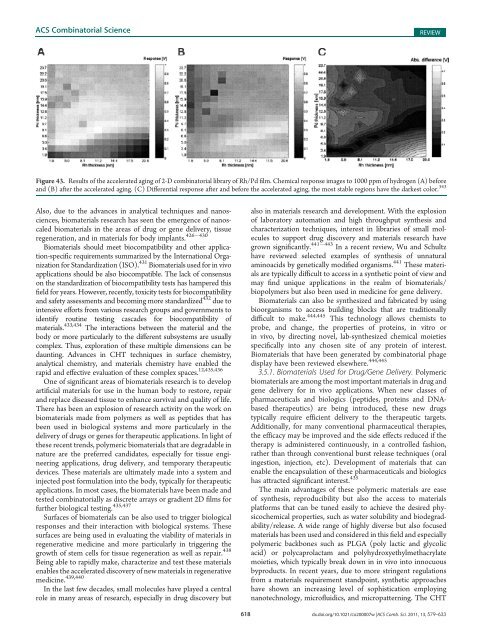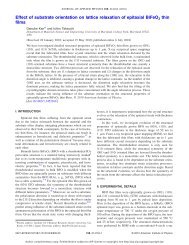Combinatorial and High-Throughput Screening of Materials ...
Combinatorial and High-Throughput Screening of Materials ...
Combinatorial and High-Throughput Screening of Materials ...
You also want an ePaper? Increase the reach of your titles
YUMPU automatically turns print PDFs into web optimized ePapers that Google loves.
ACS <strong>Combinatorial</strong> Science<br />
REVIEW<br />
Figure 43. Results <strong>of</strong> the accelerated aging <strong>of</strong> 2-D combinatorial library <strong>of</strong> Rh/Pd film. Chemical response images to 1000 ppm <strong>of</strong> hydrogen (A) before<br />
<strong>and</strong> (B) after the accelerated aging. (C) Differential response after <strong>and</strong> before the accelerated aging, the most stable regions have the darkest color. 343<br />
Also, due to the advances in analytical techniques <strong>and</strong> nanosciences,<br />
biomaterials research has seen the emergence <strong>of</strong> nanoscaled<br />
biomaterials in the areas <strong>of</strong> drug or gene delivery, tissue<br />
426 430<br />
regeneration, <strong>and</strong> in materials for body implants.<br />
Biomaterials should meet biocompatibility <strong>and</strong> other application-specific<br />
requirements summarized by the International Organization<br />
for St<strong>and</strong>ardization (ISO). 431 Biomaterials used for in vivo<br />
applications should be also biocompatible. The lack <strong>of</strong> consensus<br />
on the st<strong>and</strong>ardization <strong>of</strong> biocompatibility tests has hampered this<br />
field for years. However, recently, toxicity tests for biocompatibility<br />
<strong>and</strong> safety assessments <strong>and</strong> becoming more st<strong>and</strong>ardized 432 due to<br />
intensive efforts from various research groups <strong>and</strong> governments to<br />
identify routine testing cascades for biocompatibility <strong>of</strong><br />
materials. 433,434 The interactions between the material <strong>and</strong> the<br />
body or more particularly to the different subsystems are usually<br />
complex. Thus, exploration <strong>of</strong> these multiple dimensions can be<br />
daunting. Advances in CHT techniques in surface chemistry,<br />
analytical chemistry, <strong>and</strong> materials chemistry have enabled the<br />
rapid <strong>and</strong> effective evaluation <strong>of</strong> these complex spaces. 12,435,436<br />
One <strong>of</strong> significant areas <strong>of</strong> biomaterials research is to develop<br />
artificial materials for use in the human body to restore, repair<br />
<strong>and</strong> replace diseased tissue to enhance survival <strong>and</strong> quality <strong>of</strong> life.<br />
There has been an explosion <strong>of</strong> research activity on the work on<br />
biomaterials made from polymers as well as peptides that has<br />
been used in biological systems <strong>and</strong> more particularly in the<br />
delivery <strong>of</strong> drugs or genes for therapeutic applications. In light <strong>of</strong><br />
these recent trends, polymeric biomaterials that are degradable in<br />
nature are the preferred c<strong>and</strong>idates, especially for tissue engineering<br />
applications, drug delivery, <strong>and</strong> temporary therapeutic<br />
devices. These materials are ultimately made into a system <strong>and</strong><br />
injected post formulation into the body, typically for therapeutic<br />
applications. In most cases, the biomaterials have been made <strong>and</strong><br />
tested combinatorially as discrete arrays or gradient 2D films for<br />
further biological testing. 435,437<br />
Surfaces <strong>of</strong> biomaterials can be also used to trigger biological<br />
responses <strong>and</strong> their interaction with biological systems. These<br />
surfaces are being used in evaluating the viability <strong>of</strong> materials in<br />
regenerative medicine <strong>and</strong> more particularly in triggering the<br />
growth <strong>of</strong> stem cells for tissue regeneration as well as repair. 438<br />
Being able to rapidly make, characterize <strong>and</strong> test these materials<br />
enables the accelerated discovery <strong>of</strong> new materials in regenerative<br />
medicine. 439,440<br />
In the last few decades, small molecules have played a central<br />
role in many areas <strong>of</strong> research, especially in drug discovery but<br />
also in materials research <strong>and</strong> development. With the explosion<br />
<strong>of</strong> laboratory automation <strong>and</strong> high throughput synthesis <strong>and</strong><br />
characterization techniques, interest in libraries <strong>of</strong> small molecules<br />
to support drug discovery <strong>and</strong> materials research have<br />
grown significantly. 441 443 In a recent review, Wu <strong>and</strong> Schultz<br />
have reviewed selected examples <strong>of</strong> synthesis <strong>of</strong> unnatural<br />
aminoacids by genetically modified organisms. 441 These materials<br />
are typically difficult to access in a synthetic point <strong>of</strong> view <strong>and</strong><br />
may find unique applications in the realm <strong>of</strong> biomaterials/<br />
biopolymers but also been used in medicine for gene delivery.<br />
Biomaterials can also be synthesized <strong>and</strong> fabricated by using<br />
bioorganisms to access building blocks that are traditionally<br />
difficult to make. 444,445 This technology allows chemists to<br />
probe, <strong>and</strong> change, the properties <strong>of</strong> proteins, in vitro or<br />
in vivo, by directing novel, lab-synthesized chemical moieties<br />
specifically into any chosen site <strong>of</strong> any protein <strong>of</strong> interest.<br />
Biomaterials that have been generated by combinatorial phage<br />
display have been reviewed elsewhere. 444,445<br />
3.5.1. Biomaterials Used for Drug/Gene Delivery. Polymeric<br />
biomaterials are among the most important materials in drug <strong>and</strong><br />
gene delivery for in vivo applications. When new classes <strong>of</strong><br />
pharmaceuticals <strong>and</strong> biologics (peptides, proteins <strong>and</strong> DNAbased<br />
therapeutics) are being introduced, these new drugs<br />
typically require efficient delivery to the therapeutic targets.<br />
Additionally, for many conventional pharmaceutical therapies,<br />
the efficacy may be improved <strong>and</strong> the side effects reduced if the<br />
therapy is administered continuously, in a controlled fashion,<br />
rather than through conventional burst release techniques (oral<br />
ingestion, injection, etc). Development <strong>of</strong> materials that can<br />
enable the encapsulation <strong>of</strong> these pharmaceuticals <strong>and</strong> biologics<br />
has attracted significant interest. 435<br />
The main advantages <strong>of</strong> these polymeric materials are ease<br />
<strong>of</strong> synthesis, reproducibility but also the access to materials<br />
platforms that can be tuned easily to achieve the desired physicochemical<br />
properties, such as water solubility <strong>and</strong> biodegradability/release.<br />
A wide range <strong>of</strong> highly diverse but also focused<br />
materials has been used <strong>and</strong> considered in this field <strong>and</strong> especially<br />
polymeric backbones such as PLGA (poly lactic <strong>and</strong> glycolic<br />
acid) or polycaprolactam <strong>and</strong> polyhydroxyethylmethacrylate<br />
moieties, which typically break down in in vivo into innocuous<br />
byproducts. In recent years, due to more stringent regulations<br />
from a materials requirement st<strong>and</strong>point, synthetic approaches<br />
have shown an increasing level <strong>of</strong> sophistication employing<br />
nanotechnology, micr<strong>of</strong>luidics, <strong>and</strong> micropatterning. The CHT<br />
618 dx.doi.org/10.1021/co200007w |ACS Comb. Sci. 2011, 13, 579–633












